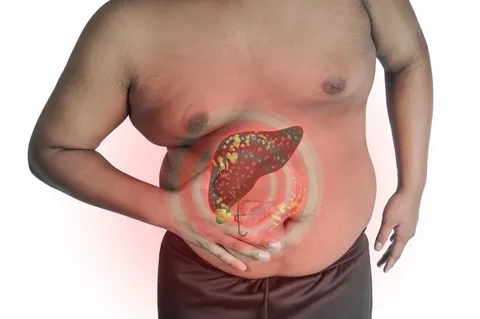What is Fatty Liver Disease?
Fatty liver disease, known clinically as hepatic steatosis, refers to the abnormal accumulation of fat within liver cells. This condition can primarily be categorized into two types: alcoholic fatty liver disease (AFLD) and non-alcoholic fatty liver disease (NAFLD). AFLD is typically caused by excessive alcohol consumption, leading to inflammation and damage to liver cells. In contrast, NAFLD occurs in individuals who drink little to no alcohol. This form has gained attention in recent years as it is increasingly prevalent worldwide and can progress to more severe liver conditions such as non-alcoholic steatohepatitis (NASH), fibrosis, and eventually cirrhosis.
The prevalence of fatty liver disease is on the rise, affecting an estimated 25% of the global population. Factors contributing to this condition include obesity, insulin resistance, type 2 diabetes, and hyperlipidemia (high cholesterol levels). These factors often coexist, as they form a cluster commonly referred to as metabolic syndrome. The physiological mechanism underlying fat accumulation in the liver involves an imbalance between the influx of fatty acids and their export or oxidation. In individuals with obesity or diabetes, there is an increased delivery of free fatty acids to the liver, coupled with a decreased oxidative capacity and impaired export mechanisms, which ultimately leads to the accumulation of lipids.
It is essential to recognize the growing concerns surrounding fatty liver disease as a public health issue. Lifestyle choices, including diet and physical activity, played a vital role in preventing and managing this condition. Patients diagnosed with fatty liver disease should consult healthcare professionals for appropriate evaluations and to explore tailored management strategies. Maintaining a healthy weight and adopting a balanced diet can significantly impact the progression of liver conditions and overall metabolic health.
Identifying Symptoms of Fatty Liver
Fatty liver disease, or hepatic steatosis, often presents with a variety of symptoms that can significantly impact a person’s quality of life. Commonly reported symptoms include fatigue, persistent discomfort in the upper right abdominal region, and an overall feeling of malaise. These manifestations are crucial for early recognition, as many individuals may not exhibit these symptoms until the disease has progressed.
In addition to fatigue and abdominal discomfort, some individuals with fatty liver may experience changes in appetite, accompanied by unexplained weight loss. As the condition advances, more severe symptoms may become apparent, including jaundice, which is characterized by yellowing of the skin and eyes. This phenomenon indicates a significant liver dysfunction and requires immediate medical attention.
While many people diagnosed with fatty liver disease are asymptomatic during the early stages, the importance of recognizing early signs cannot be overstated. Symptoms can vary widely from person to person, and some individuals may experience atypical manifestations. These discrepancies can lead to a delay in diagnosis, underscoring the need for awareness regarding the potential symptoms of fatty liver. Consistent monitoring of one’s health, particularly for those at risk due to factors such as obesity, diabetes, or excessive alcohol consumption, is vital.
Moreover, the lack of obvious symptoms in the early stages can lead to a false sense of security, encouraging individuals to overlook potential health concerns. Therefore, it is essential for those who are at risk or have a family history of liver disease to discuss any changes in their health with a healthcare provider, even when symptoms are not apparent. Recognizing and addressing symptoms at an early stage can significantly affect management strategies and improve long-term outcomes for affected individuals.
Effective Management Strategies for Fatty Liver
Managing fatty liver disease requires a multi-faceted approach that integrates lifestyle modifications with medical interventions. Central to this management is the adoption of a balanced diet. Individuals diagnosed with fatty liver should focus on consuming a diet rich in fruits, vegetables, whole grains, and lean proteins. This dietary shift helps reduce liver fat, and foods high in omega-3 fatty acids, such as fatty fish, can further support liver health by reducing inflammation.
In addition to dietary changes, regular physical activity is critical in managing fatty liver. Engaging in moderate-intensity aerobic exercises for at least 150 minutes per week has demonstrated significant benefits. Activities such as brisk walking, cycling, or swimming can help improve overall fitness and facilitate weight loss, which is particularly beneficial for those with fatty liver disease. Strength training exercises are also recommended twice a week to enhance muscle tone and metabolism.
Weight loss stands out as one of the most effective long-term strategies for managing fatty liver disease. Even a modest weight loss of 5-10% of body weight can lead to notable improvements in liver health and fat reduction. For individuals struggling to achieve weight loss through lifestyle changes alone, medical interventions may come into play. Certain medications, such as insulin sensitizers or vitamin E, may be prescribed based on individual assessments by healthcare professionals.
Finally, regular check-ups with a healthcare provider are essential in monitoring liver function and managing fatty liver disease effectively. These appointments allow for routine blood tests and imaging studies, ensuring that the liver’s condition is continuously evaluated. By embracing a holistic strategy that combines dietary management, physical activity, potential pharmacological treatments, and consistent medical oversight, individuals can significantly enhance their liver health and overall well-being.
When to Seek Medical Advice
It is crucial to recognize the appropriate circumstances under which individuals experiencing symptoms of fatty liver should seek medical advice. Fatty liver disease, while often asymptomatic in its early stages, can lead to serious complications if not monitored properly. If you experience symptoms such as unexplained fatigue, abdominal discomfort, or jaundice—indicated by yellowing of the skin or eyes—it is imperative to consult a healthcare professional promptly.
Additionally, individuals with risk factors for fatty liver disease—including obesity, diabetes, high cholesterol, or excessive alcohol consumption—should consider regular consultations to monitor their liver health. Healthcare providers may recommend specific tests such as liver function tests (LFTs) or imaging studies like ultrasound or MRI to assess the condition of the liver. These evaluations are integral in determining the extent of liver damage if fatty liver disease is present.
It is also important to inform your healthcare provider about any related health issues or lifestyle factors that could exacerbate liver conditions. A healthcare professional may provide lifestyle modifications, such as changes in diet and physical activity levels, aimed at managing symptoms and preventing disease progression. They may also facilitate referrals to specialists, such as hepatologists or dietitians, for more focused management.
Regular monitoring of liver health is essential, particularly for those diagnosed with fatty liver disease. This can help to prevent potential complications such as fibrosis, cirrhosis, or liver cancer. As the context surrounding liver health evolves, remaining proactive and attending routine follow-up appointments can be instrumental. This is the optimal way to ensure timely intervention and maintain overall well-being.






